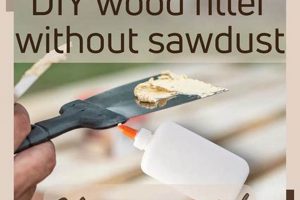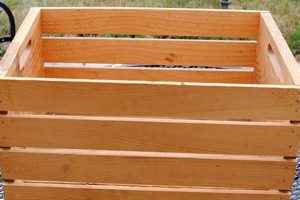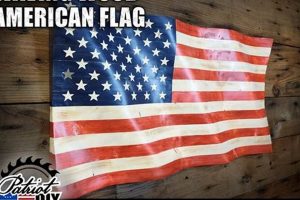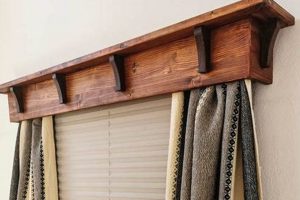A crafted representation of a national emblem, typically American, constructed from timber and assembled by the individual, constitutes a decorative piece often hung on walls. These items frequently feature painted or stained stripes and stars, simulating the appearance of the symbolized banner. The creation process generally involves cutting, sanding, and finishing separate pieces of wood, then affixing them together.
The appeal of such projects lies in the opportunity for personalization and creative expression. These handcrafted items present a tangible display of patriotism and artisanal skill. Furthermore, the act of constructing one provides an engaging activity with a tangible result. Historically, flags have represented identity and allegiance; these homemade versions provide a contemporary interpretation of that symbolism.
The following discussion will delve into specific techniques for building, finishing, and displaying these unique works. Subsequent sections will also cover material selection, design variations, and safety considerations pertinent to the process.
Tips for Wood Flag Construction
Achieving a high-quality, aesthetically pleasing, and structurally sound wood flag requires careful planning and execution. The following tips provide guidance on essential aspects of the construction process.
Tip 1: Material Selection: Choosing appropriate wood is critical. Pine offers affordability and ease of workability, while hardwoods such as oak or maple provide enhanced durability and a more refined appearance. Consider the intended environment and select a wood type suitable for those conditions.
Tip 2: Accurate Measurement and Cutting: Precision is paramount for a visually cohesive final product. Ensure precise measurements and accurate cuts using appropriate tools such as a miter saw or table saw. Inaccurate cuts can lead to misalignment and an unprofessional appearance.
Tip 3: Proper Sanding Techniques: Sanding ensures a smooth surface for painting or staining. Begin with a coarse grit sandpaper to remove imperfections and gradually transition to finer grits for a polished finish. Thorough sanding enhances the final aesthetic and promotes even stain or paint absorption.
Tip 4: Strategic Assembly: Employ appropriate joinery techniques, such as wood glue and screws or nails, for secure assembly. Consider the wood’s grain direction to prevent warping or splitting. Clamping the components during glue drying is essential for a strong, lasting bond.
Tip 5: Precise Star Placement: The star field requires meticulous attention to detail. Utilize templates or precise measurements to ensure accurate star placement. Consider using a stencil or individual star cutouts for consistent and professional results.
Tip 6: Quality Finishing: Applying a protective finish enhances the flag’s durability and aesthetic appeal. Select a finish appropriate for the intended environment, such as an exterior-grade sealant for outdoor display. Multiple thin coats provide better protection than a single heavy coat.
Tip 7: Secure Mounting: Select suitable mounting hardware based on the flag’s size and weight. Ensure the mounting surface is capable of supporting the flag’s weight. Secure mounting prevents accidental falls and potential damage.
Adherence to these guidelines improves the likelihood of creating a visually appealing, durable, and well-crafted wooden flag. These techniques contribute to a finished product that effectively represents the intended symbolism and showcases craftsmanship.
The subsequent section will explore design variations and advanced techniques, enabling further customization and refinement of these distinctive wood-based representations.
1. Material Selection
Material selection constitutes a foundational element in the fabrication of a wooden flag. The choice of wood directly influences the aesthetic appeal, structural integrity, and longevity of the finished product. Careful consideration of various wood species and their inherent properties is essential for a successful outcome.
- Wood Species and Grain
Different wood species possess varying grain patterns, colors, and textures. Pine offers a cost-effective option with a readily available straight grain, suitable for painting. Conversely, hardwoods like oak or maple exhibit more intricate grain patterns and greater density, lending themselves to stained finishes and enhanced durability. Grain orientation affects wood stability; vertical grain is generally more resistant to warping than flat grain. The intended finish and aesthetic preferences should guide the selection of wood species and grain.
- Dimensional Stability
Dimensional stability refers to a wood’s ability to resist changes in size and shape due to variations in moisture content. Woods with high dimensional stability, such as cedar or redwood, are preferred for outdoor applications where exposure to fluctuating humidity levels is inevitable. Unstable woods, like poplar, may be prone to warping or cracking if not properly sealed and maintained. Matching the wood’s stability to the intended environment is crucial for long-term structural integrity.
- Workability and Finishing Properties
Workability encompasses the ease with which wood can be cut, shaped, and sanded. Softwoods are generally easier to work with than hardwoods, requiring less effort and specialized tools. Finishing properties relate to how well a wood accepts and retains stains, paints, and sealants. Some woods, such as cherry, are known for their ability to develop rich, lustrous finishes, while others may require specific primers or sealers to achieve optimal results. The skill level of the craftsman and the desired finish dictate the choice of wood based on workability and finishing characteristics.
- Cost and Availability
The cost of different wood species can vary significantly depending on their scarcity and demand. Exotic hardwoods, such as mahogany or ebony, command premium prices due to their limited availability and desirable properties. Locally sourced woods offer a more sustainable and often more cost-effective alternative. Availability also influences material selection; choosing a wood species readily accessible from local suppliers simplifies the procurement process and reduces transportation costs. Balancing cost considerations with aesthetic and performance requirements is essential for a practical and budget-conscious approach.
These facets of material selection underscore the crucial role it plays in the creation of a wooden flag. Selecting the correct wood species, considering stability, finishing properties, and resource implications ensures the longevity and beauty of the product. Failing to take into account the material will result in a poorly represented flag.
2. Precision Cutting
Accurate dimensioning and shaping of individual wooden components are paramount to the successful fabrication of a flag. This meticulous process, termed precision cutting, directly influences the overall aesthetic appeal, structural integrity, and representational accuracy of the final product.
- Dimensional Accuracy and Alignment
Precise cutting ensures that each stripe and star field element adheres to the specified dimensions. Inaccurate cuts result in misaligned stripes, uneven star spacing, and a distorted overall appearance. Maintaining dimensional accuracy is crucial for a visually cohesive and professional-looking flag. Examples of errors include variations in stripe width and inconsistencies in the size of the star field, each directly impacting the final aesthetic.
- Joint Integrity and Structural Stability
Accurate cuts facilitate tight, secure joints between individual pieces. Gaps or misalignments at joints weaken the overall structure and compromise the flag’s longevity. Precision cutting promotes flush, seamless connections, enhancing the flag’s resistance to warping, twisting, and other forms of structural failure. Wood glue and mechanical fasteners (screws, nails) function most effectively when the joined pieces are precisely cut. Poor execution in this area results in structural instability and premature deterioration.
- Efficient Material Utilization
Careful planning and accurate cutting minimize material waste. Precision cutting optimizes the yield from raw lumber, reducing costs and promoting resource conservation. Strategic layout techniques, such as nesting components to minimize offcuts, enhance material efficiency. Wasteful cutting practices increase material expenses and contribute to environmental burden.
- Tool Selection and Technique
Achieving precision requires the use of appropriate cutting tools, such as miter saws, table saws, and laser cutters. Selecting the right tool for the task and employing proper cutting techniques are essential for accuracy. Dull blades, improper feed rates, and unstable work surfaces compromise cut quality. Maintaining sharp blades, using proper safety equipment, and employing controlled cutting techniques minimize errors and enhance precision.
These aspects underscore the critical role of precision cutting in crafting wooden flags. Accurate cuts ensure aesthetic quality, structural soundness, and efficient use of materials. The quality of cutting influences the final integrity of flag. Attention to these factors enables the production of a flag that accurately represents its intended symbolism.
3. Surface Preparation
Effective surface preparation is indispensable for a successful wooden flag creation. It constitutes a critical phase that directly influences the adhesion of finishes, the visual quality of the final product, and the overall longevity of the piece. Proper surface preparation ensures a smooth, consistent substrate for paints, stains, and sealants, optimizing their performance and enhancing the flag’s aesthetic appeal.
- Sanding and Smoothing
Sanding eliminates imperfections, such as splinters, rough edges, and mill marks, from the wood surface. Progressively finer grits of sandpaper are employed to create a smooth, uniform texture. Proper sanding ensures consistent stain or paint absorption, preventing blotchy or uneven coloration. Inadequate sanding results in a rough finish and compromised adhesion of subsequent coatings. For example, failure to remove planer marks from rough-sawn lumber leads to visible imperfections beneath the paint or stain.
- Cleaning and Degreasing
Cleaning removes dust, dirt, oil, and other contaminants that can interfere with finish adhesion. A tack cloth or solvent-based cleaner is typically used to wipe down the sanded surface. Removing these contaminants ensures a clean substrate for optimal bonding of paints, stains, and sealants. Residue from handling, such as fingerprints or grease, can compromise finish adhesion and lead to premature peeling or flaking. Degreasing is particularly important for oily woods such as teak or rosewood.
- Filling Imperfections
Wood filler or putty is used to fill nail holes, gaps, and other minor imperfections in the wood surface. Filling these imperfections creates a smooth, seamless surface for finishing. Color-matched fillers are preferred to minimize visibility. Failure to fill imperfections results in a less polished appearance and potential points of moisture ingress. For instance, unfilled nail holes become focal points and detract from the overall quality of the flag.
- Priming and Sealing
Priming creates a uniform base for subsequent coats of paint or stain. A primer seals the wood surface, preventing excessive absorption of the finish and promoting even coloration. Priming also enhances adhesion and increases the durability of the paint or stain. A properly primed surface ensures uniform color and prolongs the lifespan of the finish. For example, priming before painting white stripes onto pine prevents the tannins in the wood from bleeding through and discoloring the paint.
These elements of surface preparation are essential considerations in wooden flag construction. Proper execution of each element ensures a visually appealing, durable, and long-lasting finished product. Inadequate surface preparation compromises the integrity of the finish and detracts from the flag’s overall aesthetic appeal. Each aspect will contribute to a well crafted flag. Conversely, adequate preparation will increase the quality.
4. Assembly Methods
The methods employed to join individual components constitute a critical determinant of a wood flag’s structural integrity and aesthetic outcome. The choice of assembly technique directly impacts the flag’s ability to withstand environmental stressors, maintain dimensional stability, and present a visually cohesive appearance. Effective assembly methods are paramount to the creation of a lasting and representative symbol.
- Mechanical Fasteners (Screws and Nails)
Mechanical fasteners, such as screws and nails, provide a robust means of joining wooden components. Screws offer superior holding power compared to nails, particularly in applications where shear strength is critical. Pre-drilling pilot holes is essential to prevent splitting the wood, especially when using hardwoods. The type of fastener (e.g., wood screws, drywall screws, finishing nails) should be selected based on the wood species, joint type, and desired aesthetic. For instance, countersinking screws and covering them with wood filler creates a seamless appearance, while exposed nails may contribute to a rustic aesthetic. Improper fastener selection or installation compromises joint strength and detracts from the overall quality.
- Adhesive Bonding (Wood Glue)
Wood glue, specifically formulated for woodworking applications, creates a strong and durable bond between wooden surfaces. The type of glue (e.g., PVA glue, polyurethane glue, epoxy) should be selected based on the wood species, joint type, and environmental conditions. Proper clamping pressure is essential during the glue curing process to ensure optimal adhesion. Wood glue creates joints that are often stronger than the wood itself. Surface preparation, including cleaning and sanding, is crucial for effective adhesive bonding. Failure to apply adequate clamping pressure or to properly prepare the surfaces results in a weak bond and potential joint failure.
- Joinery Techniques (Rabbets, Dadoes, and Miter Joints)
Joinery techniques, such as rabbets, dadoes, and miter joints, create interlocking connections that enhance joint strength and stability. Rabbets and dadoes provide increased surface area for glue adhesion and mechanical interlocking, while miter joints create seamless corners. These techniques require precise cutting and fitting to ensure accurate alignment and optimal strength. Joinery techniques distribute stress more evenly across the joint, reducing the risk of failure. Employing these techniques requires proficiency with woodworking tools and a thorough understanding of wood behavior. Improperly executed joinery compromises structural integrity and aesthetic quality.
- Backing Support and Frame Construction
Adding a backing support or frame structure provides additional reinforcement and prevents warping or twisting of the flag. The backing can be constructed from plywood, solid wood, or other rigid materials. Attaching the backing to the flag with screws or adhesive provides added stability and resistance to environmental stresses. The frame can also serve as a mounting system for hanging the flag. A well-designed backing and frame enhance the flag’s durability and prolong its lifespan. Failure to provide adequate backing support can lead to warping, cracking, or separation of the individual components over time.
The choice of assembly method for a wood flag depends on factors such as the size and complexity of the design, the desired aesthetic, and the skill level of the craftsman. A combination of techniques, such as adhesive bonding reinforced with mechanical fasteners, often provides the most robust and aesthetically pleasing result. Careful consideration of these factors is crucial for creating a lasting and representative symbol.
5. Finishing Techniques
Finishing techniques are integral to the creation of a wooden flag. These procedures enhance the aesthetic appeal, protect the wood substrate, and contribute significantly to the longevity of the finished product. The selection and application of appropriate finishing techniques are essential for achieving a durable and visually appealing result.
- Staining and Coloration
Staining imparts color to the wood, accentuating the grain and enhancing visual depth. Different stain types (oil-based, water-based, gel stains) offer varying levels of penetration and color intensity. The choice of stain color should align with the desired aesthetic of the flag, often reflecting historical or symbolic color schemes. Uneven stain application or incompatible stain-wood pairings can result in blotchy or inconsistent coloration, detracting from the flag’s overall appearance. For example, staining a pine flag with a dark stain may require a wood conditioner to ensure even absorption.
- Painting and Detailing
Painting provides a solid color finish, masking the wood grain and allowing for intricate detailing. Acrylic or latex paints are commonly used due to their durability and ease of application. Proper surface preparation, including priming, is crucial for optimal paint adhesion and color uniformity. Precise painting techniques are essential for accurately rendering the flag’s stripes, stars, and other symbolic elements. Inaccurate painting or insufficient surface preparation can lead to peeling, chipping, or fading of the paint, compromising the flag’s visual integrity.
- Sealing and Protection
Sealing protects the wood from moisture, UV radiation, and other environmental factors that can cause damage. Polyurethane, varnish, and lacquer are commonly used sealants, each offering varying levels of protection and sheen. Proper sealant application prevents warping, cracking, and fading of the wood and finish. Multiple thin coats of sealant are generally preferred over a single thick coat to ensure even coverage and optimal protection. Failure to adequately seal the wood can lead to premature degradation, particularly in outdoor environments. For example, a wooden flag displayed outdoors without a UV-resistant sealant is susceptible to fading and cracking.
- Distressing and Antiquing
Distressing techniques create a weathered or aged appearance, adding character and visual interest to the flag. Techniques such as sanding, scraping, and staining are used to simulate wear and tear. Distressing can enhance the flag’s historical aesthetic or create a rustic, vintage look. However, excessive or poorly executed distressing can appear artificial and detract from the flag’s overall appeal. A carefully applied antiquing glaze can enhance the distressed look and add depth to the finish.
The selection and execution of appropriate finishing techniques are critical for achieving a high-quality, durable, and visually appealing wooden flag. These techniques not only enhance the aesthetic qualities of the flag but also protect the wood from environmental damage, ensuring its longevity and preserving its symbolic value. Thoughtful application guarantees a long lasting and visually stunning piece.
6. Symbolic Accuracy
The faithful representation of established symbols constitutes a critical aspect of constructing a wooden flag. Deviation from accepted standards can undermine the intended meaning and impact of the artifact, potentially diminishing its value as a symbol of national identity.
- Star Count and Arrangement
The number of stars and their precise arrangement in the canton of a wooden flag are of paramount importance. The United States flag, for example, features fifty stars representing the fifty states. Any deviation from this number or an inaccurate arrangement (rows, spacing) fundamentally alters the symbol, rendering it a misrepresentation. Each change has an impact on the symbol itself.
- Stripe Count and Color Sequence
The arrangement of the stripes, specifically the number and color sequence, directly relates to the historical representation of the original flag. The presence of thirteen stripes, alternating between red and white, represents the original thirteen colonies. An incorrect number of stripes or an altered color sequence distorts the historical narrative and compromises the flag’s symbolic integrity. This creates inaccuracy in the representation.
- Color Fidelity
Adherence to established color standards is essential for maintaining symbolic accuracy. The precise shades of red, white, and blue, often defined by government standards or historical precedent, carry specific connotations. Deviations from these established colors can dilute or alter the intended message. For instance, using a faded or off-hue blue can diminish the flag’s vibrancy and symbolic impact. Color correctness is a must to have high fidelity.
- Proportion and Dimensions
The flag’s proportions and overall dimensions contribute to its visual harmony and symbolic impact. Adhering to established ratios ensures that the flag appears balanced and visually appealing. Distorted proportions can create an unsettling or unintentionally disrespectful representation. These deviations distract from the intended representation and impact.
In summary, symbolic accuracy is not merely an aesthetic consideration in wooden flag construction but a fundamental requirement for maintaining the integrity of the represented symbol. Faithful adherence to established standards ensures that the flag effectively conveys its intended message and preserves its significance as a symbol of national identity and cultural values. Attention to detail is required for a good product.
Frequently Asked Questions
The following addresses commonly encountered queries regarding the construction of flags made from timber. This information aims to clarify key aspects of the process, ensuring a comprehensive understanding for individuals undertaking such projects.
Question 1: What is the recommended wood type for a durable flag?
Hardwoods, such as oak or maple, offer superior durability and resistance to environmental factors. However, softwoods like pine are more easily worked and provide a cost-effective alternative, particularly when properly sealed.
Question 2: How can warping be prevented in a flag construction?
Employing kiln-dried lumber, sealing all surfaces with a moisture-resistant finish, and incorporating a backing support structure are essential for minimizing the risk of warping.
Question 3: What are the best methods for achieving accurate star placement?
Templates, stencils, or pre-calculated measurements are recommended for ensuring precise star positioning. The use of a grid system can also facilitate accurate alignment.
Question 4: How should the flag be finished for outdoor display?
Exterior-grade paints, stains, and sealants containing UV inhibitors are necessary to protect the wood from sunlight, moisture, and temperature fluctuations. Regular maintenance is essential for long-term preservation.
Question 5: What tools are essential for building a flag?
A miter saw or table saw for accurate cuts, a sander for surface preparation, a drill for fastener installation, and measuring tools are fundamental. Clamps are necessary for secure assembly during glue drying.
Question 6: How can the colors of the flag be accurately reproduced?
Referencing official color standards (e.g., the Pantone Matching System) and using high-quality paints or stains is crucial for maintaining color fidelity. Test swatches are recommended to verify color accuracy before application.
In summary, the successful creation of a wooden flag requires careful attention to material selection, construction techniques, and finishing methods. Adherence to these guidelines will result in a durable and aesthetically pleasing representation.
The subsequent section will explore advanced design considerations, expanding on the foundational principles outlined herein.
Conclusion
This article has explored the multifaceted aspects of wooden flag construction, ranging from material selection and precision cutting to assembly methods and symbolic accuracy. Adherence to these principles ensures the creation of a durable and aesthetically pleasing artifact that faithfully represents the intended symbolism. The integration of appropriate techniques leads to a superior final product.
The construction of such an item requires careful planning, meticulous execution, and a commitment to accuracy. The final product serves not only as a decorative element but also as a tangible expression of national identity and artistic skill. Further exploration of advanced techniques and design variations will continue to refine and enhance this craft.







